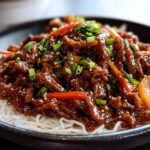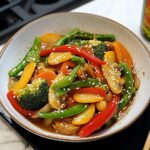The heart and soul of Vietnamese cuisine in one bowl—Pho is a deeply aromatic, beef-based noodle soup infused with warm spices like star anise and cinnamon. Slow-simmered to perfection, the broth is delicately layered and beautifully clear, making every slurp a flavor-packed journey.
Traditionally topped with thin slices of tender beef, fresh herbs, bean sprouts, and a generous squeeze of lime, this dish delivers both comfort and freshness. Whether you’re a first-timer or a lifelong pho lover, making it at home allows you to savor the authentic flavors of Vietnam, right from your kitchen.
Full Recipe:
Aromatics:
-
2 large onions, halved
-
150g (5oz) ginger, sliced down the center
Spices:
-
10 star anise
-
4 cinnamon quills
-
4 cardamom pods
-
3 cloves
-
1.5 tbsp coriander seeds
Beef & Broth Base:
-
1.5kg (3lb) beef brisket
-
1kg (2lb) meaty beef bones
-
1kg (2lb) marrow bones (leg, knuckle), cut to expose marrow
-
3.5 litres (15 cups) water
-
2 tbsp white sugar
-
1 tbsp salt
-
40ml (3 tbsp) fish sauce
Per Bowl (serves 6):
-
50g (1.5oz) dried rice sticks or 120g (4oz) fresh
-
30g (1oz) raw beef tenderloin, very thinly sliced
-
3–5 brisket slices
Toppings (served on the side):
-
Bean sprouts
-
Thai basil (3–5 sprigs)
-
Coriander/cilantro (3–5 sprigs)
-
Lime wedges
-
Finely sliced red chili
-
Hoisin sauce
-
Sriracha
Directions:
-
Char the onion and ginger in a dry pan until blackened. Toast all spices in a separate dry pan for 3 minutes.
-
Rinse all bones and brisket. Place in a large pot, cover with water, bring to a boil for 5 minutes. Drain and rinse bones/brisket to remove impurities.
-
Clean the pot. Refill with 3.5L water and add bones, brisket, onion, ginger, toasted spices, sugar, and salt. Simmer covered for 3 hours.
-
Remove brisket, let cool and refrigerate. Continue simmering uncovered for another 40 minutes.
-
Strain broth. Skim excess fat. Add fish sauce and adjust seasoning to taste.
-
Cook rice noodles according to package.
-
Assemble each bowl with noodles, brisket, raw beef slices. Pour hot broth (~400ml) over to cook beef instantly.
-
Serve with toppings on the side.
Prep Time: 20 minutes | Cooking Time: 3 hours 50 minutes | Total Time: 4 hours 10 minutes
Kcal: 410 kcal | Servings: 6 servings
The Essence of Vietnamese Pho
Pho (pronounced “fuh”) is much more than just a noodle soup—it is a symbol of Vietnamese culture, history, and culinary art. Deeply aromatic, intensely flavorful, and comforting on every level, pho has transcended borders to become one of the world’s most beloved bowls. With a broth that simmers for hours, absorbing the essence of charred aromatics and toasted spices, pho is both humble and sophisticated. It reflects a deep connection to Vietnamese traditions, rooted in simplicity, patience, and balance.
A Brief History of Pho
The origins of pho can be traced back to early 20th-century Northern Vietnam, likely around the Hanoi region. Though there’s debate about its exact beginnings, many historians agree that pho evolved as a fusion of Vietnamese ingredients and French colonial influence—specifically, the use of beef. Cattle were not commonly used for meat in traditional Vietnamese cuisine prior to French colonization, as water buffalo were more valued for labor.
The word “pho” may have derived from the French dish pot-au-feu, a slow-cooked beef stew. But unlike its French counterpart, Vietnamese pho uses delicate rice noodles and is layered with Southeast Asian herbs and spices, such as star anise, cinnamon, and fish sauce, transforming it into something uniquely Vietnamese.
Over the decades, pho migrated from north to south, where it picked up regional differences. Northern-style pho (Pho Bac) is more austere and broth-focused, while Southern-style pho (Pho Nam) features more garnishes, including bean sprouts, Thai basil, and hoisin sauce. After the Vietnam War, pho traveled globally with refugees, spreading across North America, Europe, and Australia, where it gained cult-like popularity.
The Broth: Heart and Soul of Pho
Ask any Vietnamese cook, and they will tell you that the broth is the lifeblood of pho. It is what separates an average bowl from an unforgettable one. To develop a rich yet clear broth, bones and brisket are first parboiled to remove impurities—this step is critical for achieving the clarity pho is known for. The cleaned bones and meat are then simmered for hours, alongside charred onion and ginger, and an aromatic blend of spices: star anise, cinnamon sticks, cardamom pods, cloves, and coriander seeds.
The alchemy of the broth lies in balance—beefy without being greasy, spiced but not overpowering, sweet yet savory. The result is a deep umami base that is light in body but rich in complexity. Fish sauce and sugar are often added at the end to round out the flavors and bring everything into harmony.
The Noodles and Meat Components
Rice noodles, specifically flat ones made from rice flour, are the standard in pho. These noodles are soft yet chewy, providing a neutral base that soaks up the flavor of the broth. Fresh rice noodles are preferred when available, but high-quality dried versions work just as well when soaked and prepared properly.
Pho is often served with thin slices of raw beef, traditionally tenderloin or sirloin, which cook instantly when submerged in the piping hot broth. In many variations, thinly sliced cooked brisket—used in the broth—also finds its way into the bowl. Other popular meat additions include beef balls, tendon, or even tripe, depending on regional preferences and personal tastes.
Toppings: Customization and Balance
One of the beauties of pho lies in its ability to be customized at the table. A traditional pho setup includes a platter of fresh garnishes: bean sprouts, Thai basil, lime wedges, sliced chili, and sawtooth herb (ngo gai). Diners add these elements according to their preferences, adjusting the texture and brightness of each bite.
Hoisin sauce and sriracha are also commonly served alongside pho, especially in the South. While purists might prefer their broth untainted, many enjoy a swirl of hoisin’s sweetness or the heat of chili sauce to amplify their pho experience.
This interactive aspect makes pho both a communal and deeply personal dish. Each bowl becomes a reflection of the individual eating it—a culinary expression molded at the table.
Cultural Significance of Pho in Vietnam
Pho is not just food in Vietnam; it is a national treasure. Served in street stalls, family kitchens, and fine restaurants alike, pho cuts across class and geography. It is a staple breakfast dish in many Vietnamese households and eateries. Early in the morning, it’s common to see people hunched over steaming bowls at plastic tables, starting their day with a warm, aromatic broth.
During family gatherings, pho is a symbol of hospitality and care. The time and effort involved in preparing it from scratch signify love and devotion. For the Vietnamese diaspora around the world, pho often represents a taste of home, evoking memories of family, tradition, and identity.
Why Make Pho at Home?
In an age where instant gratification dominates, preparing pho from scratch might seem daunting. But it is an incredibly rewarding endeavor. The slow simmering of bones and spices, the gradual transformation of water into gold-hued broth, the aroma that fills the home—it becomes more than cooking; it’s a meditative ritual.
Homemade pho also allows for full control over the quality of ingredients. You can choose grass-fed brisket, organic vegetables, and fresh herbs. It also enables you to adjust seasoning, salt levels, and spice balance to your exact preference.
While you could get a decent bowl of pho at many restaurants, the home-cooked version offers authenticity that’s hard to replicate outside a Vietnamese household. It connects you to the roots of the cuisine, to its history, and to the families who’ve perfected it over generations.
Tips for the Best Homemade Pho
-
Don’t skip the charring of aromatics. It might seem like a minor detail, but this step adds essential smokiness and depth.
-
Skim the broth frequently. The clarity of your soup depends on removing scum and fat as it simmers.
-
Use a combination of marrow and meaty bones. This ensures both richness and robust flavor.
-
Slice beef thinly. Partially freezing the beef before slicing helps achieve paper-thin cuts that cook quickly in the broth.
-
Assemble just before serving. Noodles can get mushy if they sit too long. Build each bowl fresh to preserve texture.
Modern Adaptations and Variations
Though traditional beef pho (pho bo) remains the classic, variations abound. Chicken pho (pho ga) uses a similar method with whole chickens and a lighter broth. Vegetarian pho versions substitute mushrooms and charred vegetables for the base and use soy or mushroom sauces in place of fish sauce.
In global kitchens, chefs are experimenting with fusion pho—using duck confit, lamb, or even seafood. Some use pressure cookers or Instant Pots to reduce cooking time while preserving flavor. While these adaptations vary in authenticity, they showcase pho’s incredible adaptability and universal appeal.
Conclusion: A Bowl of Harmony
Pho is not just a recipe—it is a culinary experience rooted in tradition, resilience, and the universal desire for comfort. It reflects the Vietnamese philosophy of balance: hot and cool, fresh and rich, simple yet complex.
To sip a well-made bowl of pho is to experience the soul of Vietnam. It’s a dish that invites you to slow down, engage your senses, and connect with a culture that celebrates food as both nourishment and art. Whether you’re making it for the first time or the hundredth, pho has the power to bring warmth, joy, and a sense of home to anyone who tastes it.
In a world filled with fleeting food trends, pho endures—quietly, humbly, and deliciously.





